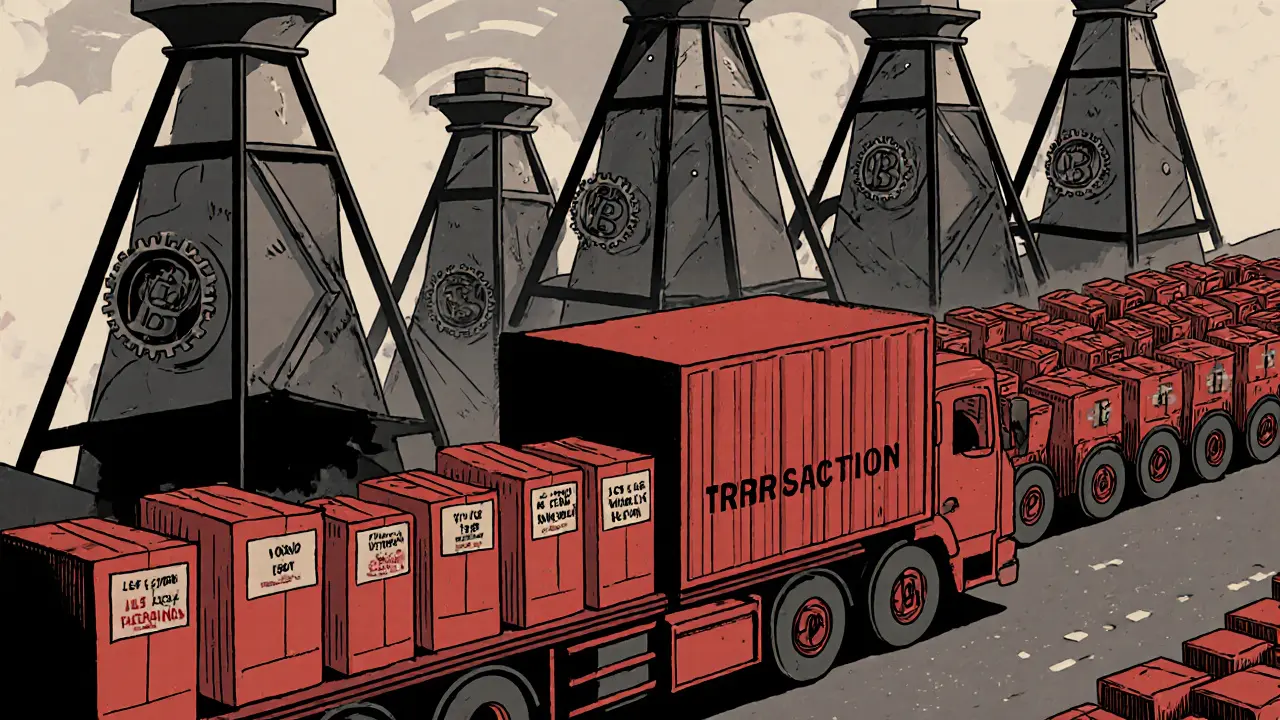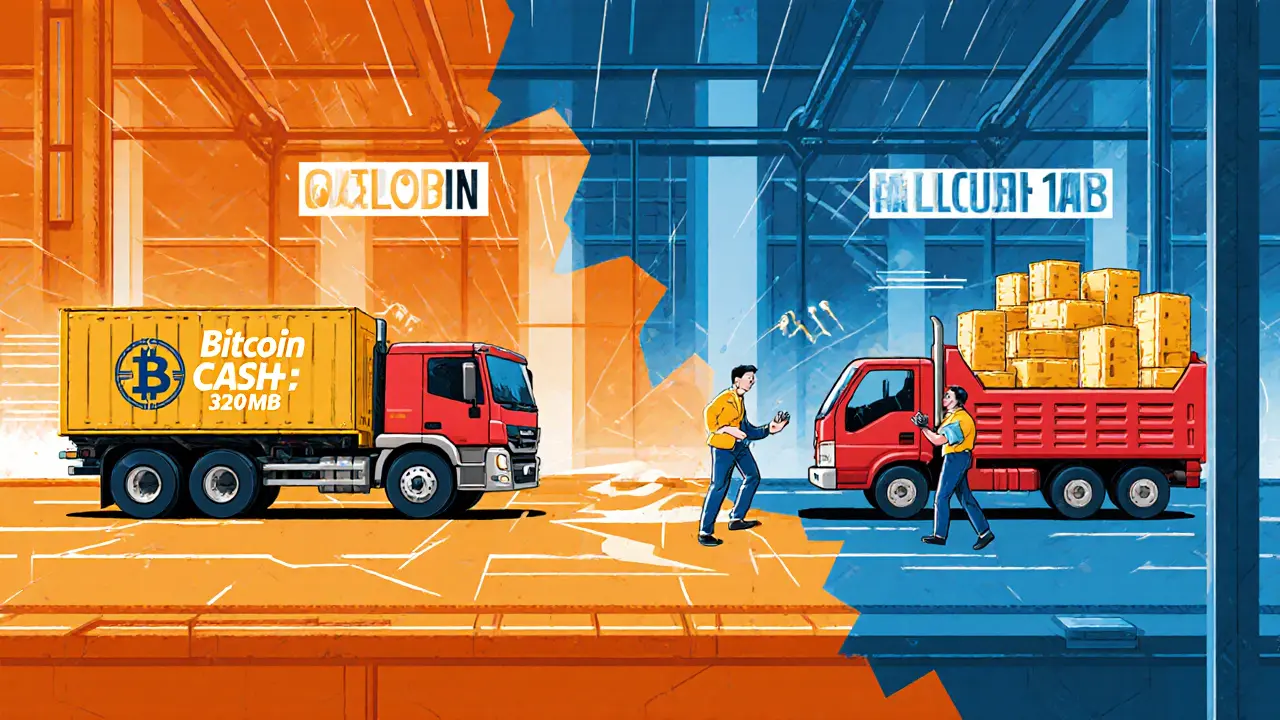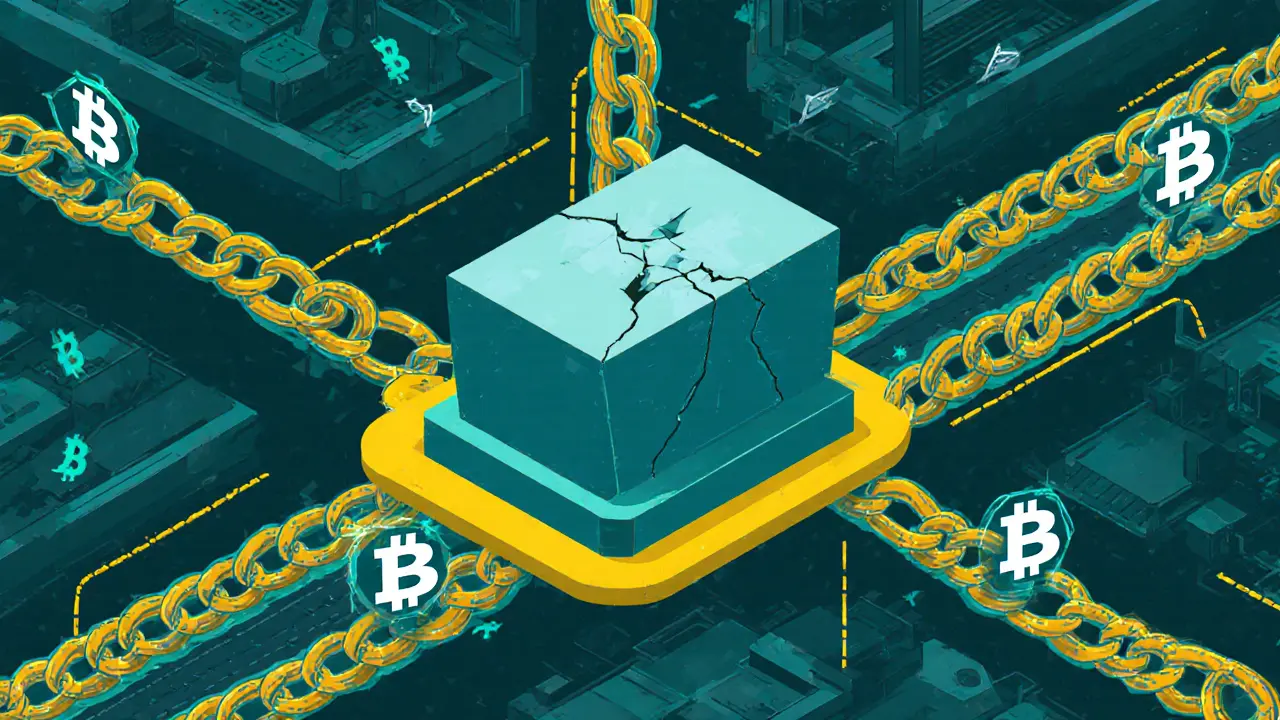How Block Size Affects Blockchain Performance
 Aug, 12 2025
Aug, 12 2025
Blockchain Throughput Calculator
Calculate Blockchain Throughput
Results
Visa processes up to 65,000 transactions per second. Your calculated throughput:
Compare with real blockchain examples:
- Bitcoin (1MB blocks): ~7 TPS
- Bitcoin Cash (32MB blocks): ~200 TPS
- Dogecoin (100MB blocks): ~1,000 TPS
Note: Larger block sizes improve throughput but reduce decentralization. Running full nodes requires more storage and bandwidth.
When you send a Bitcoin or Ethereum transaction, it doesn’t instantly appear on the ledger. It waits in a queue-sometimes for minutes, sometimes for hours-until it gets packed into a block. That block has a limit. And that limit, called block size, is one of the most powerful yet overlooked factors shaping how fast, cheap, and reliable a blockchain really is.
What Block Size Actually Means
Block size is the maximum amount of data a single block can hold. Think of it like a truck delivering packages. If the truck can only carry 10 boxes, then no matter how many packages are waiting, you’re stuck with 10 per trip. Bitcoin’s original block size was 1 megabyte (MB). That meant about 3 to 7 transactions per second. For comparison, Visa handles up to 65,000 transactions per second. The difference isn’t just technical-it’s practical.
Every transaction takes up space. A simple payment might be 250 bytes. A complex smart contract interaction could be 1,000 bytes or more. With a 1MB limit, you’re squeezing maybe 2,000 simple transactions into one block. If more people are sending transactions than the block can hold, the rest wait. And when they wait, fees go up. That’s not a bug-it’s a direct result of block size.
How Block Size Drives Throughput
Throughput-how many transactions a network can process-isn’t just about how fast blocks are made. It’s about how many fit inside each one. The formula is simple: Throughput = Block Size ÷ Average Transaction Size × Blocks per Minute.
Bitcoin’s 1MB block and 10-minute block time = ~7 TPS. Bitcoin Cash bumped the block size to 32MB. That’s 32 times more data per block. Suddenly, you’re looking at over 200 TPS under normal conditions. Dogecoin, with its 1-minute block time and 100MB blocks, can hit over 1,000 TPS. It’s not magic-it’s math.
But bigger blocks don’t automatically mean better performance. If the network can’t handle the data, the system slows down anyway. Nodes need to download, verify, and store every block. If blocks grow too big, too fast, regular users can’t run full nodes anymore. And if only big companies or data centers can validate the chain, you lose decentralization-the whole point of blockchain.
The Decentralization Trade-Off
Here’s the hard truth: bigger blocks make the network faster, but they also make it harder to participate. Running a full node on Bitcoin in 2025 requires over 600 gigabytes of storage. That’s more than most home computers have free. Add in bandwidth and processing power, and suddenly you’re looking at a $100/month cloud server just to stay synced.
That’s not a problem for big exchanges or mining pools. But it’s a death sentence for hobbyists, students, or people in developing countries trying to verify transactions on their own. The more centralized the network becomes, the more vulnerable it is to censorship, manipulation, or single points of failure.
Bitcoin SV took the extreme route-removing block size limits entirely. Theoretically, that means unlimited throughput. In practice, it led to spam attacks, bloated chains, and a network so heavy that most nodes couldn’t keep up. The result? A blockchain that’s fast on paper but broken in reality.

How Other Blockchains Handle It
Not all blockchains use fixed block sizes. Ethereum doesn’t limit block size-it limits gas. Each transaction costs gas. The total gas per block is capped at around 15 million. That’s a smarter way to control load. If demand spikes, fees rise. If demand drops, fees fall. It’s a market-driven system, not a hard cap.
Then there’s SKALE, a lesser-known network that recently hit 397.7 transactions per second with under 1.5 seconds to finality. How? They didn’t just make blocks bigger. They built 19 interconnected blockchains that work together. Each one handles a slice of the load. Total throughput? Over 7,500 TPS. That’s not a single block size win-it’s a system-wide redesign.
Cardano, Solana, and NEAR all use different tricks: faster block times, parallel processing, or proof-of-stake optimizations. They’re not just increasing block size-they’re rethinking how blocks are created, verified, and linked.
Why Bigger Isn’t Always Better
Some people think the answer is simple: just increase the block size. But it’s not that easy. Every change ripples through the whole system.
Larger blocks mean:
- More storage needed for every node
- Higher bandwidth demands
- Longer verification times
- Slower sync for new participants
- Greater risk of chain splits during network delays
In 2017, Bitcoin split into two chains-Bitcoin and Bitcoin Cash-because the community couldn’t agree on whether to increase block size. That wasn’t just a technical debate. It was a philosophical one: Is blockchain about being a global, open payment system? Or is it about being a secure, censorship-resistant store of value? Block size forces you to pick a side.
Even if you solve the technical side, the social side remains. Who gets to decide? Miners? Developers? Users? If one group pushes a change and others refuse, you get a fork. And forks are messy. They confuse users. They split security. They damage trust.

Alternatives to Bigger Blocks
There’s another way: don’t put everything on the main chain.
Layer-two solutions like the Lightning Network for Bitcoin or Optimism and Arbitrum for Ethereum move most transactions off-chain. Only the final settlement happens on the main blockchain. That means you can process thousands of payments per second without changing the block size at all. It’s like using express lanes on a highway-you still have the same roads, but most traffic flows faster.
Sharding is another approach. Instead of one chain handling everything, you split the network into dozens or hundreds of smaller chains. Each one processes its own transactions. Ethereum is moving this way with its 2025 upgrade. The result? Higher throughput without sacrificing decentralization.
State channels and sidechains work similarly. They let users transact privately, then lock in the final state on-chain. This reduces congestion and keeps fees low.
What’s the Right Block Size?
There’s no universal answer. It depends on what you need.
If you’re building a digital gold store, like Bitcoin, you might prefer smaller blocks. Security and decentralization matter more than speed. You’re not trying to compete with Visa-you’re trying to outlast governments.
If you’re building a gaming platform or a microtransaction system, you need speed. You need low fees. You need to handle hundreds of transactions per second. In that case, a larger block size-or a layer-two solution-is essential.
For most real-world applications today, the best path isn’t just increasing block size. It’s combining approaches: a secure base layer, efficient layer-two scaling, and smart consensus rules that adapt to demand.
What’s Next for Block Size?
The era of simple block size increases is ending. The next wave of blockchain performance won’t come from bigger blocks-it’ll come from smarter systems.
Blockchains are evolving into layered networks. The base layer handles security and finality. The upper layers handle speed and scale. Bitcoin’s Lightning Network already processes millions of transactions monthly without touching the main chain. Ethereum’s rollups do the same.
Future blockchains will likely have dynamic block sizes-adjusting automatically based on demand. Or they’ll use proof-of-stake with variable block intervals. Or they’ll rely on cross-chain interoperability to spread load across multiple chains.
One thing is clear: block size alone won’t save any blockchain. But ignoring it? That’s how networks become slow, expensive, and irrelevant.
Jean Manel
October 29, 2025 AT 06:04Block size? Please. The real issue is that Bitcoiners are still living in 2012. We're not running a postal service-we're trying to build the future. If you can't handle 32MB blocks, maybe you shouldn't be running a node. Stop crying about decentralization and start upgrading your hardware. This isn't a yoga retreat, it's a blockchain.
William P. Barrett
October 30, 2025 AT 07:46It's funny how we treat block size like it's a dial we can just turn up. But blockchain isn't a car engine-it's a democracy. Every time we increase the limit, we're silently voting out the people who can't afford to keep up. Is speed worth losing the very people who made this possible? Maybe the answer isn't bigger blocks, but better incentives for node operators.
Cory Munoz
October 30, 2025 AT 19:58I get why people want faster transactions. I really do. But I also remember when I ran a full node on an old laptop and felt like I was part of something real. Now? It feels like we're building a luxury skyscraper on top of a foundation that's slowly crumbling. Maybe we need to ask: who are we building this for? And who are we leaving behind?
Jasmine Neo
October 31, 2025 AT 22:37Bitcoin Cash is the only sane chain. Anyone still clinging to 1MB is either a crypto purist with no real-world experience or a crypto bro who thinks 'decentralization' means 'I get to feel superior while my transactions take 4 hours.' Wake up. The world moved on. Your nostalgia is killing innovation.
Ron Murphy
November 1, 2025 AT 11:40Interesting how Ethereum’s gas cap feels more elegant than Bitcoin’s hard limit. It’s like pricing water-you pay more when it’s scarce, less when it’s abundant. No arbitrary cap, just market signals. Makes me wonder if block size should even be a fixed number anymore.
Prateek Kumar Mondal
November 2, 2025 AT 21:35Nick Cooney
November 4, 2025 AT 02:35Wait so you're telling me that making blocks bigger means my grandma can't run a node anymore? But... but... that's like saying if you can't afford a Tesla, you shouldn't be allowed to drive. I mean, come on. I typed this on my phone and it took 2 seconds. Who cares if the blockchain is 10TB? I'm not storing it. 😅
Clarice Coelho Marlière Arruda
November 5, 2025 AT 21:53so like... if block size is the truck and transactions are the boxes... what if we just... made more trucks? like... at the same time? 🤔
Brian Collett
November 6, 2025 AT 23:31SKALE hitting 7,500 TPS? That’s wild. But I’ve seen so many ‘revolutionary’ chains crash after 6 months. How many of these ‘high-throughput’ networks actually have real users, or are just devs testing in a sandbox? Let’s not confuse speed with sustainability.
Allison Andrews
November 8, 2025 AT 00:09There’s a quiet tragedy here: we’re optimizing for throughput while forgetting that the soul of blockchain is participation. Not speed. Not scale. Not efficiency. The ability for anyone, anywhere, to verify the truth without permission. If we lose that, we’re just another database with a fancy name.
Wayne Overton
November 9, 2025 AT 16:15Alisa Rosner
November 10, 2025 AT 04:14Okay, so here's the thing 💡: Bigger blocks = more data = more storage = more cost = fewer nodes = less secure. But Layer 2 = off-chain = cheaper = faster = still secured by the main chain! 🚀 So why are we still stuck on this 1MB vs 32MB debate? We already have the solution-it's called rollups and sidechains! Let's stop arguing and start building!
MICHELLE SANTOYO
November 11, 2025 AT 19:50Ohhh so now we’re pretending decentralization is a ‘trade-off’? Like it’s a menu option? ‘I’ll have the speed, and I’ll skip the decentralization, please.’ No. No. NO. You can’t just swap the soul of a movement for faster transactions. This isn’t a product update. This is a moral failure wrapped in whitepaper.
Lena Novikova
November 12, 2025 AT 10:26Olav Hans-Ols
November 13, 2025 AT 18:28I love how this thread turned into a philosophy class. Honestly? I think we’re all right in some way. Speed matters. Decentralization matters. But maybe the real win is letting different chains serve different needs. Bitcoin as digital gold. Ethereum as the global computer. SKALE as the gaming engine. No one-size-fits-all. Let a thousand flowers bloom 🌸
Kevin Johnston
November 14, 2025 AT 23:50